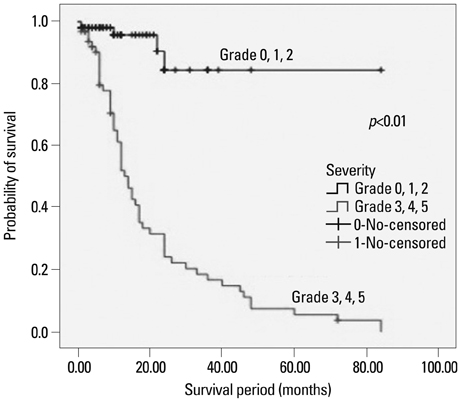Risk Factors Associated with Amputation-Free Survival in Patient with Diabetic Foot Ulcers
- Affiliations
-
- 1Department of Orthopaedic Surgery, Armed Force Hampyeong Hospital, Hampyeong, Korea.
- 2Department of Orthopaedic Surgery, Seoul National University Bundang Hospital, Seongnam, Korea. oasis100@empal.com
- 3Department of Vascular Surgery, Seoul National University Bundang Hospital, Seongnam, Korea.
- 4Department of Orthopaedic Surgery, Myongji Hospital, Goyang, Korea.
- 5Department of Orthopaedic Surgery, Konyang University Hospital, Daejeon, Korea.
- KMID: 1799505
- DOI: http://doi.org/10.3349/ymj.2014.55.5.1373
Abstract
- PURPOSE
To determine the 1-year survival rate, 1-year amputation-free survival rate and the risk factors of amputation for patients with diabetic foot ulcers.
MATERIALS AND METHODS
One hundred seventy-three patients with diabetic foot ulcers were included in our study. Mean patient age was 67.5 (range, 29 to 87, SD +/-11.4) years. 74% of the patients were male. Time from study entry to amputation and time to death were evaluated separately as censored event times by Kaplan-Meier curves and log-rank tests. A multivariate Cox proportional hazards regression analysis was carried out for determining the risk factors of amputation.
RESULTS
The survival rate and amputation-free survival rate were 96.5% (n=167), 65.9% (n=114), respectively, over one year study period. Severity of ulcer was the strongest significant risk factor of amputation [hazard ratio (HR): 7.99; confidence interval (CI): 3.12 to 20.47]. Peripheral artery disease was also independent risk factor of amputation (HR: 2.64; CI: 1.52 to 4.59).
CONCLUSION
In assessing the prognosis of diabetic foot ulcers, clinicians should consider the severity of ulcer and presence of peripheral artery disease. Our study provides important insights into clinical practice and supplementary information for both physicians and patients.
MeSH Terms
Figure
Cited by 4 articles
-
Trends in Lower Limb Amputation in Patients with Diabetic Foot Based on Vascular Intervention of Peripheral Arterial Disease in Korea: a Population-based Nationwide Study
Jahyung Kim, Dong-il Chun, Sangyoung Kim, Hyeon-Jong Yang, Jae Heon Kim, Jae-ho Cho, Young Yi, Woo Jong Kim, Sung Hun Won
J Korean Med Sci. 2019;34(26):. doi: 10.3346/jkms.2019.34.e178.The Amputation Rate and Associated Risk Factors within 1 Year after the Diagnosis of Diabetic Foot Ulcer
Dong-Il Chun, Min Chul Jeon, Sung-Woo Choi, Yong-Beom Kim, Jae-Hwi Nho, Sung Hun Won
J Korean Foot Ankle Soc. 2016;20(3):121-125. doi: 10.14193/jkfas.2016.20.3.121.Risk factors affecting amputation in diabetic foot
Jun Ho Lee, Ji Sung Yoon, Hyoung Woo Lee, Kyu Chang Won, Jun Sung Moon, Seung Min Chung, Yin Young Lee
Yeungnam Univ J Med. 2020;37(4):314-320. doi: 10.12701/yujm.2020.00129.Current Trends in the Treatment of Diabetic Foot: Analysis of the Korean Foot and Ankle Society (KFAS) Member Survey
Sung Hun Won, Tae-Hong Min, Dong-Il Chun, Su-Young Bae
J Korean Foot Ankle Soc. 2022;26(1):30-39. doi: 10.14193/jkfas.2022.26.1.30.
Reference
-
1. Boulton AJ. The pathway to foot ulceration in diabetes. Med Clin North Am. 2013; 97:775–790.
Article2. Boulton AJ. [The diabetic foot]. Khirurgiia (Sofiia). 2001; 57:5–8.3. Stiegler H. [Diabetic foot syndrome]. Herz. 2004; 29:104–115.4. Lauterbach S, Kostev K, Kohlmann T. Prevalence of diabetic foot syndrome and its risk factors in the UK. J Wound Care. 2010; 19:333–337.
Article5. Pscherer S, Dippel FW, Lauterbach S, Kostev K. Amputation rate and risk factors in type 2 patients with diabetic foot syndrome under real-life conditions in Germany. Prim Care Diabetes. 2012; 6:241–246.
Article6. Singh N, Armstrong DG, Lipsky BA. Preventing foot ulcers in patients with diabetes. JAMA. 2005; 293:217–228.
Article7. Gregg EW, Sorlie P, Paulose-Ram R, Gu Q, Eberhardt MS, Wolz M, et al. Prevalence of lower-extremity disease in the US adult population >=40 years of age with and without diabetes: 1999-2000 national health and nutrition examination survey. Diabetes Care. 2004; 27:1591–1597.
Article8. Winkley K, Stahl D, Chalder T, Edmonds ME, Ismail K. Risk factors associated with adverse outcomes in a population-based prospective cohort study of people with their first diabetic foot ulcer. J Diabetes Complications. 2007; 21:341–349.
Article9. Morbach S, Furchert H, Gröblinghoff U, Hoffmeier H, Kersten K, Klauke GT, et al. Long-term prognosis of diabetic foot patients and their limbs: amputation and death over the course of a decade. Diabetes Care. 2012; 35:2021–2027.10. Abbott CA, Carrington AL, Ashe H, Bath S, Every LC, Griffiths J, et al. The North-West Diabetes Foot Care Study: incidence of, and risk factors for, new diabetic foot ulceration in a community-based patient cohort. Diabet Med. 2002; 19:377–384.
Article11. Sun JH, Tsai JS, Huang CH, Lin CH, Yang HM, Chan YS, et al. Risk factors for lower extremity amputation in diabetic foot disease categorized by Wagner classification. Diabetes Res Clin Pract. 2012; 95:358–363.
Article12. Beks PJ, Mackaay AJ, de Neeling JN, de Vries H, Bouter LM, Heine RJ. Peripheral arterial disease in relation to glycaemic level in an elderly Caucasian population: the Hoorn study. Diabetologia. 1995; 38:86–96.
Article13. Sharp CS, Bessman AN, Wagner FW Jr, Garland D. Microbiology of deep tissue in diabetic gangrene. Diabetes Care. 1978; 1:289–292.
Article14. Wukich DK, Hobizal KB, Brooks MM. Severity of diabetic foot infection and rate of limb salvage. Foot Ankle Int. 2013; 34:351–358.
Article15. Resnick HE, Lindsay RS, McDermott MM, Devereux RB, Jones KL, Fabsitz RR, et al. Relationship of high and low ankle brachial index to all-cause and cardiovascular disease mortality: the Strong Heart Study. Circulation. 2004; 109:733–739.
Article16. Boyko EJ, Ahroni JH, Stensel V, Forsberg RC, Davignon DR, Smith DG. A prospective study of risk factors for diabetic foot ulcer. The Seattle Diabetic Foot Study. Diabetes Care. 1999; 22:1036–1042.
Article



